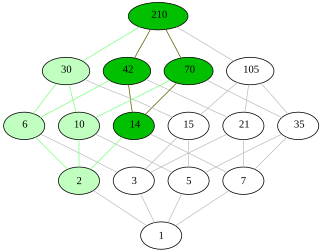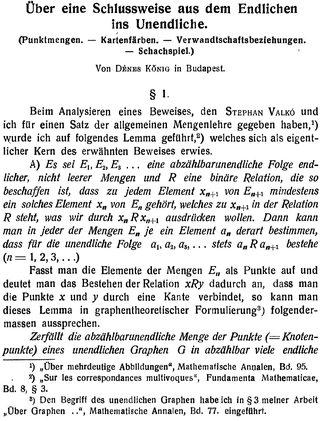
In the mathematical field of order theory, an ultrafilter on a given partially ordered set is a certain subset of namely a maximal filter on that is, a proper filter on that cannot be enlarged to a bigger proper filter on

In mathematics, the system of hyperreal numbers is a way of treating infinite and infinitesimal quantities. The hyperreals, or nonstandard reals, *R, are an extension of the real numbers R that contains numbers greater than anything of the form
In the mathematical discipline of set theory, forcing is a technique for proving consistency and independence results. Intuitively, forcing can be thought of as a technique to expand the set theoretical universe to a larger universe by introducing a new "generic" object .

Kőnig's lemma or Kőnig's infinity lemma is a theorem in graph theory due to the Hungarian mathematician Dénes Kőnig who published it in 1927. It gives a sufficient condition for an infinite graph to have an infinitely long path. The computability aspects of this theorem have been thoroughly investigated by researchers in mathematical logic, especially in computability theory. This theorem also has important roles in constructive mathematics and proof theory.
In the mathematical discipline of set theory, 0# is the set of true formulae about indiscernibles and order-indiscernibles in the Gödel constructible universe. It is often encoded as a subset of the integers, or as a subset of the hereditarily finite sets, or as a real number. Its existence is unprovable in ZFC, the standard form of axiomatic set theory, but follows from a suitable large cardinal axiom. It was first introduced as a set of formulae in Silver's 1966 thesis, later published as Silver (1971), where it was denoted by Σ, and rediscovered by Solovay, who considered it as a subset of the natural numbers and introduced the notation O#.
In mathematics, the Boolean prime ideal theorem states that ideals in a Boolean algebra can be extended to prime ideals. A variation of this statement for filters on sets is known as the ultrafilter lemma. Other theorems are obtained by considering different mathematical structures with appropriate notions of ideals, for example, rings and prime ideals, or distributive lattices and maximal ideals. This article focuses on prime ideal theorems from order theory.
In mathematical logic, descriptive set theory (DST) is the study of certain classes of "well-behaved" subsets of the real line and other Polish spaces. As well as being one of the primary areas of research in set theory, it has applications to other areas of mathematics such as functional analysis, ergodic theory, the study of operator algebras and group actions, and mathematical logic.
In mathematics, the axiom of determinacy is a possible axiom for set theory introduced by Jan Mycielski and Hugo Steinhaus in 1962. It refers to certain two-person topological games of length ω. AD states that every game of a certain type is determined; that is, one of the two players has a winning strategy.
A subset of a topological space has the property of Baire, or is called an almost open set, if it differs from an open set by a meager set; that is, if there is an open set such that is meager.
A Dynkin system, named after Eugene Dynkin is a collection of subsets of another universal set satisfying a set of axioms weaker than those of 𝜎-algebra. Dynkin systems are sometimes referred to as 𝜆-systems or d-system. These set families have applications in measure theory and probability.
Determinacy is a subfield of set theory, a branch of mathematics, that examines the conditions under which one or the other player of a game has a winning strategy, and the consequences of the existence of such strategies. Alternatively and similarly, "determinacy" is the property of a game whereby such a strategy exists. Determinacy was introduced by Gale and Stewart in 1950, under the name "determinateness".
In descriptive set theory, within mathematics, Wadge degrees are levels of complexity for sets of reals. Sets are compared by continuous reductions. The Wadge hierarchy is the structure of Wadge degrees. These concepts are named after William W. Wadge.
In mathematical logic, the Borel hierarchy is a stratification of the Borel algebra generated by the open subsets of a Polish space; elements of this algebra are called Borel sets. Each Borel set is assigned a unique countable ordinal number called the rank of the Borel set. The Borel hierarchy is of particular interest in descriptive set theory.
In the mathematical field of set theory, the proper forcing axiom (PFA) is a significant strengthening of Martin's axiom, where forcings with the countable chain condition (ccc) are replaced by proper forcings.
In descriptive set theory, a tree over a product set is said to be homogeneous if there is a system of measures such that the following conditions hold:
In descriptive set theory, the Borel determinacy theorem states that any Gale–Stewart game whose payoff set is a Borel set is determined, meaning that one of the two players will have a winning strategy for the game. A Gale-Stewart game is a possibly infinite two-player game, where both players have perfect information and no randomness is involved.
In mathematics, an ultralimit is a geometric construction that assigns to a sequence of metric spaces Xn a limiting metric space. The notion of an ultralimit captures the limiting behavior of finite configurations in the spaces Xn and uses an ultrafilter to avoid the process of repeatedly passing to subsequences to ensure convergence. An ultralimit is a generalization of the notion of Gromov–Hausdorff convergence of metric spaces.
This is a glossary of set theory.

In the mathematical field of set theory, an ultrafilter is a maximal proper filter: it is a filter on a given non-empty set which is a certain type of non-empty family of subsets of that is not equal to the power set of and that is also "maximal" in that there does not exist any other proper filter on that contains it as a proper subset. Said differently, a proper filter is called an ultrafilter if there exists exactly one proper filter that contains it as a subset, that proper filter (necessarily) being itself.











